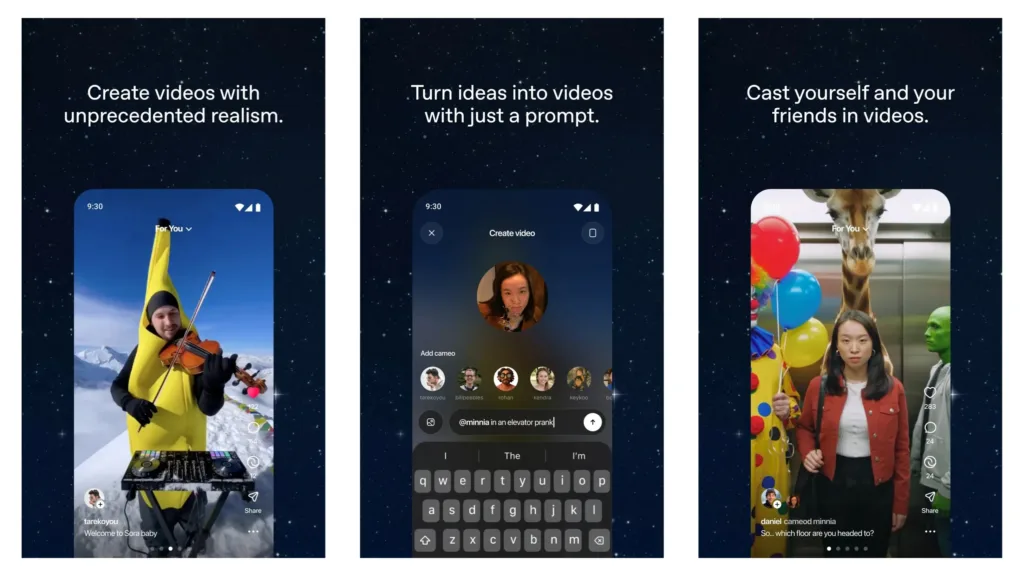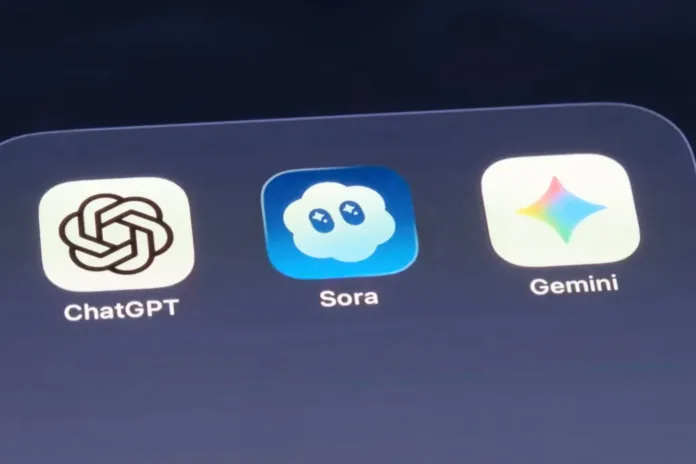Table of Contents
OpenAI has officially released its Sora app for Android, expanding access to one of the most talked-about AI video platforms in recent months. Following a blockbuster launch on iOS, the Android rollout marks a major step in OpenAI’s strategy to make AI video creation mainstream.
Sora App Expands OpenAI’s AI Video Vision

According to OpenAI’s announcement, the Sora Android app is now available through the Google Play Store in the United States, Canada, Japan, Korea, Taiwan, Thailand, and Vietnam. This move significantly widens its user base and positions OpenAI to compete directly with visual-first social platforms that rely on short-form video content.
SquaredTech notes that Sora is more than just a creative experiment, it represents OpenAI’s first large-scale consumer push into social video. The company, best known for its text and image AI tools, is now venturing deeper into entertainment, content creation, and social sharing through a product that merges generative AI with user creativity.
Read More About Our Article of Amazon Pharmacy to introduce vending machines for prescription medications Published on October 12th, 2025 SquaredTech
When Sora first appeared on iOS in September, it took less than a week to cross 1 million downloads. That level of adoption placed it among the fastest-growing apps of 2025. Android’s inclusion now expands that reach exponentially, especially in Asia, where Android dominates the mobile landscape.
How OpenAI’s Sora App Redefines AI Video Creation
At its core, OpenAI’s Sora functions as a full-fledged AI-powered video creation tool with a social feed similar to TikTok or Instagram Reels. But instead of uploading live footage, users create short videos generated by AI. The app provides tools to generate, remix, and share these clips directly within the platform.
The Sora interface displays a continuous scroll of AI-generated videos where users can interact, comment, and remix clips from other creators. This feed-based structure gives Sora the appeal of a social network, while still focusing on creative AI expression.
A major feature that sets Sora apart is its “cameo” mode. This tool allows users to include themselves or friends in AI-generated scenes. The technology uses facial recognition and motion mapping to blend real human likenesses with AI-generated backgrounds and actions. For example, a user can appear in a fantasy city, a historical reenactment, or even as part of a cinematic short—all created directly on their smartphone in minutes.
We observe that this feature makes Sora more interactive and personal than other AI video tools currently available. It bridges the gap between traditional social media and generative AI by turning users into characters inside their own creations.
In terms of technology, OpenAI’s Sora uses the same underlying models that power the company’s text-to-video research projects. Each clip is generated using deep learning algorithms trained on large-scale visual data, enabling realistic textures, movements, and lighting. The app’s interface simplifies this complexity, allowing users to simply type a scene prompt and watch the AI render it into a video within seconds.
Here’s a concise look at how Sora compares to other short-form platforms, as compiled by SquaredTech:
| Feature | Sora (OpenAI) | TikTok | Instagram Reels |
|---|---|---|---|
| Content Source | AI-generated videos | User-recorded videos | User-recorded videos |
| Customization | Text prompts, AI remixing, cameo feature | Filters, music, editing tools | Filters, music, editing tools |
| Privacy Controls | Opt-in content visibility, AI moderation | Public by default | Public by default |
| Platform Focus | AI creativity and storytelling | Entertainment and trends | Lifestyle and branding |
This comparison highlights how OpenAI is introducing a new layer of creativity that extends beyond recording reality—it creates entirely new worlds.
Controversy Over Deepfakes and Copyright
Despite the excitement surrounding its creative tools, Sora’s launch hasn’t been free of criticism. Over the past few weeks, OpenAI has faced scrutiny regarding how the app handles deepfake generation and copyright protection.
The controversy began when early users noticed that the app’s AI systems could potentially create videos resembling real public figures or copyrighted content. This sparked discussions among digital rights advocates about the need for stricter identity verification and transparent watermarking in AI-generated media.
Initially, OpenAI had implemented an opt-out policy that allowed rightsholders to request removal of their likeness or content. However, after significant backlash from artists, creators, and advocacy groups, the company reversed its approach. OpenAI now requires explicit consent before AI-generated representations of identifiable individuals can be shared publicly.
Our editorial team notes that this shift demonstrates OpenAI’s growing awareness of the ethical dimensions surrounding generative AI. The company’s new policy is a direct response to concerns about digital impersonation and unauthorized content use, both of which have become pressing issues in AI-driven media.
OpenAI has also introduced moderation systems that automatically detect and block potentially harmful content, including fake news, explicit imagery, or videos that mimic real people without consent. However, experts say full transparency and public accountability will still be crucial as Sora’s user base expands.
This debate isn’t limited to Sora. Across the tech industry, AI-generated media raises legal and moral questions about ownership, authenticity, and creative rights. OpenAI’s decision to address these issues proactively may set a precedent for other companies entering the AI video space.
Why Sora’s Android Launch Matters
The release of Sora on Android represents more than just a technical rollout—it’s a strategic global expansion for OpenAI’s consumer ecosystem. By entering markets like Japan, Korea, and Southeast Asia, the company is positioning itself where mobile video culture is strongest.
Our analysis suggests that Sora could quickly become a hub for AI-based storytelling, especially among young creators who already use platforms like TikTok and CapCut. The Android launch allows OpenAI to tap into regions where smartphones serve as the primary creative tool, opening opportunities for AI-generated entertainment to become mainstream.
From a broader perspective, Sora marks a shift in OpenAI’s identity. While the company has long focused on productivity tools like ChatGPT and Codex, it is now venturing into AI-driven media creation and social engagement. This move places OpenAI alongside companies like Meta, Google, and ByteDance in the race to define the future of visual content.
Sora’s Android launch also signals the start of a new competition among AI video platforms. As users explore the boundaries of what AI can visualize, creators will push for higher quality, faster rendering, and more personalization. OpenAI’s early advantage lies in its strong research base and massive user trust from ChatGPT and DALL·E.
SquaredTech’s Take: The Future of AI Video Creation
From SquaredTech’s editorial perspective, Sora’s expansion to Android marks a turning point for generative AI in entertainment. It shows how AI tools are transitioning from experimental models into everyday creative platforms.
By giving people the ability to make short, cinematic AI videos directly on their phones, OpenAI is effectively democratizing video production. A single tap can now produce what once required studios, actors, and expensive effects software. This could reshape digital storytelling for millions of users who lack technical training but possess creative imagination.
At the same time, SquaredTech emphasizes that innovation must come with responsibility. The ongoing discussion around deepfakes and digital ownership reflects the growing need for ethical frameworks in AI creativity. OpenAI’s decision to tighten its content policies is a sign that it recognizes the importance of public trust in sustaining the app’s success.
As Android users begin to explore Sora’s capabilities, it’s likely we’ll see a surge of AI-generated short films, music clips, and visual experiments across social feeds. The app could redefine how people think about authorship and imagination in the digital age.
For now, OpenAI’s Sora stands as a reminder that the future of video may not depend on cameras or editing software—but on the creative power of algorithms. With the Android launch, that future is now open to millions more.
Stay Updated: Artificial Intelligence


